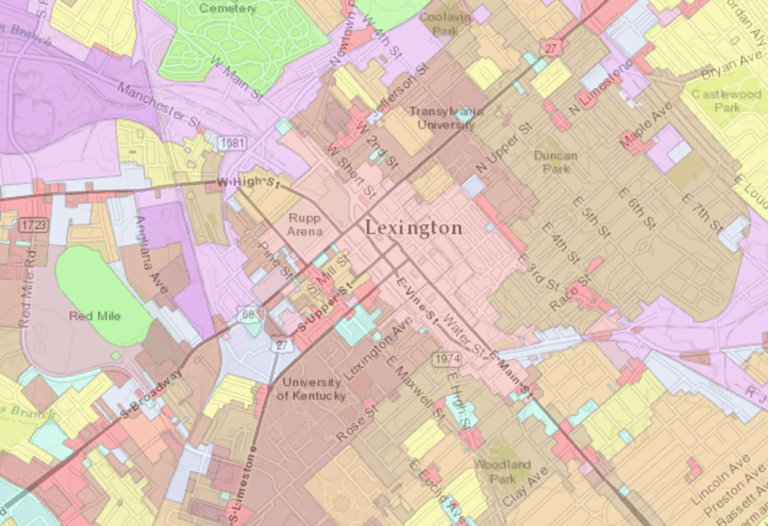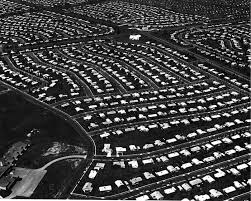Physical Address
304 North Cardinal St.
Dorchester Center, MA 02124
Physical Address
304 North Cardinal St.
Dorchester Center, MA 02124

Lexington, Kentucky is a wonderful place, and that’s getting to be a problem. There’s nothing intrinsically wrong with the city: its urban amenities, thriving information economy, and unique local culture have brought in throngs of economic migrants from locales as exotic as Appalachia, Mexico, and the Rust Belt. The problem, rather, is that the city isn’t zoned to support this newfound attention. Over the past five years, the city has grown by an estimated 18,000 residents, putting Lexington’s population at approximately 314,488. Lexington has nearly tripled in size since 1970 and the trend shows no signs of stopping, with an estimated 100,000 new residents arriving by 2030. Despite this growth, new development has largely lagged behind: despite the boom in new residents, the city has only permitted the construction of 6,021 new housing units over the past five years—not an awful ratio when compared to a San Francisco, but still putting us firmly on the path toward shortages. The lion’s share of this new development has taken the form of new single-family houses on the periphery of town. Create your own infographics. Sources: ACS/Census Bureau At the risk of sounding like a broken record, there’s nothing intrinsically wrong with single-family housing on the periphery of town. Yet in the case of Lexington, it’s suspect as a sustainable source of affordable housing. Lexington was the first American city to adopt an urban growth boundary (UGB), a now popular land-use regulation that limits outward urban expansion. As originally conceived, the UGB program isn’t such a bad idea: the city would simultaneously preserve nearby farmland and natural areas (especially important for Lexington, given our idyllic surrounding countryside) while easing restrictions on infill development. Create your own infographics. Source: Census Bureau The trouble with Lexington is that the city has undertaken […]
Because of work obligations, I listened to only about a third of today’s Cato Institute discussion on urban sprawl. I heard some of Randall O’Toole’s talk and some of the question-and-answer period. O’Toole said high housing prices don’t correlate with “zoning” just with “growth constraints.” But the cities with strict regionwide growth constraints aren’t necessarily high cost cities like New York and Boston, but mid-size, moderately expensive regions like Seattle and Portland. He says that if land use rules raise housing prices they violate the Fair Housing Act. Maybe this should be the case, but it isn’t. Government can still regulate in ways that raise housing prices, but just have to show reasonable justification for those policies under “disparate impact” doctrine. He also says cities would be less dense without zoning. Is he aware that most city regulations limit density rather than mandating density? O’Toole says growth constraints are why American home ownership rates are lower than in Third World countries and that the natural rate of home ownership is 75 percent. But why are home ownership rates so low in sprawling Sun Belt cities? For example, metro Houston’s home ownership rate is about 59 percent – higher than New York or San Francisco, but lower than Philadelphia or Pittsburgh. The highest home ownership rates are in Rust Belt regions like Akron, I suspect because of low levels of mobility. Some things he gets right: 1) public participation in land use process is harmful because it leads to more restrictions, not less; (2) the mortgage interest deduction doesn’t make much difference in home ownership rates.

Urban Institute Press • 2005 • 494 pages • $32.50 paperback In Private Neighborhoods and the Transformation of Local Government, Robert H. Nelson effectively frames the discussion of what minimal government might look like in terms of personal choices based on local knowledge. He looks at the issue from the ground up rather than the top down. Nelson argues that while all levels of American government have been expanding since World War II, people have responded with a spontaneous and massive movement toward local governance. This has taken two main forms. The first is what he calls the “privatization of municipal zoning,” in which city zoning boards grant changes or exemptions to developers in exchange for cash payments or infrastructure improvements. “Zoning has steadily evolved in practice toward a collective private property right. Many municipalities now make zoning a saleable item by imposing large fees for approving zoning changes,” Nelson writes. In one sense, of course, this is simply developers openly buying back property rights that government had previously taken from the free market, and “privatization” may be the wrong word for it. For Nelson, however, it is superior to rigid land-use controls that would prevent investors from using property in the most productive way. Following Ronald Coase, Nelson evidently believes it is more important that a tradable property right exists than who owns it initially. The second spontaneous force toward local governance has been the expansion of private neighborhood associations and the like. According to the author, “By 2004, 18 percent—about 52 million Americans—lived in housing within a homeowner’s association, a condominium, or a cooperative, and very often these private communities were of neighborhood size.” Nelson views both as positive developments on the whole. They are, he argues, a manifestation of a growing disenchantment with the “scientific management” of […]
I was rereading the Obama Administration’s surprisingly market-oriented policy paper on zoning and affordable housing, and saw one good point that I had never really thought about. One common anti-development argument is that government should subsidize housing for the poor instead of allowing the construction of upper-class housing that might eventually filter down to the poor (or cause older middle-class housing to do so). The policy paper points out, however, that “HUD’s existing project-based and housing choice vouchers could serve more families if the per-unit cost wasn’t pushed higher and higher by rents rising in the face of barriers to new development.” In other words, high market rents make subsidies more expensive, which in turn means that government can subsidize fewer units with the same dollar. In other words, high market rents make it harder, not easier, for government to subsidize housing.

The University of Chicago Press has published a “definitive” edition of F. A. Hayek’s The Constitution of Liberty under the editorial guidance of long-time Hayek scholar Ronald Hamowy. Given my interest in urban issues, it’s a good time for me to focus on chapter 22, “Housing and Town Planning.” It has several insights that I really like, but given the constraints of this column, for now I’ll talk about Hayek’s take on rent control. I must confess that it was several years after I became interested in the nature and significance of cities that I learned that Hayek had written anything on what we in the United States call “urban planning.” (Well, that’s not quite true; I did read The Constitution of Liberty as a graduate student, but in those days I didn’t appreciate how important cities are to both economic and intellectual development, so it evidently made no impression on me.) The analysis has a characteristically “Hayekian” flavor to it, by which I mean he goes beyond purely economic analysis and points out the psychological and sociological impact of certain urban policies that reinforce the dynamics of interventionism. The Economics of Rent Control Hayek’s economic analysis of rent control sounds familiar to modern students of political economy perhaps because it’s so widely (though not universally) accepted. This was hardly the case in 1960, when his book was first published. Hayek points out that despite the good intentions of those who support it, “any fixing of rents below the market price inevitably perpetuates the housing shortage.” That’s because at the artificially low rents the quantity demanded exceeds the quantity supplied. One effect of the chronic housing shortage that rent control produces is a drop in the rate at which apartments and flats would normally turn over. Instead, rent-controlled housing becomes […]
The Atlantic Magazine’s Citylab web page ran an interview with Joel Kotkin today. Kotkin seems to think we need more of something called “localism”, stating: “Growth of state control has become pretty extreme in California, and I think we’re going to see more of that in the country in general, where you have housing decisions that should be made at local level being made by the state and the federal level too. You have general erosion of local control.” In fact, land use decisions are generally made by local governments–which is why it is so hard to get new housing built. This is as true in California as it is anyplace else; when Gov. Brown tried to make it easier for developers to bypass local zoning so they can build new housing, the state legislature squashed him. Local zoning has become more restrictive over time, not less. And the fact that state government has added additional layers of regulation doesn’t change that reality. But did the Atlantic note this divergence from factual reality, or even ask him a follow-up question? No, sir. Shame on them!
I just read a law review article complaining that some white areas in integrated southern counties were trying to secede from integrated school systems (thus ensuring that the countywide systems become almost all-black while the seceding areas get to have white schools), and it occurred to me that there are some similarities between American school systems and American land use regulation. In both situations, localism creates gaps between what is rational for an individual suburb or neighborhood and what is rational for a region as a whole. In particular, it is rational for each suburb to have high home prices (because that means a bigger tax base)- but I don’t think San Francisco-size rents and home prices are rational for a region as a whole. Similarly, it is rational for each individual neighborhood within a city to have restrictive regulations, because if one neighborhood is less restrictive it suffers from whatever burdens might result from new housing, without the broader benefit of lower citywide housing costs. How are school districts similar? Since the prestige of a neighborhood is related to its school district, and the prestige of school districts depends on their socio-economic makeup, it is rational for each suburb (or city neighborhood) to be part of a school district dominated by white children from affluent families, rather than to be part of a socially and racially diverse district. But if every middle-class or affluent area draws school district lines in a way that excludes lower-income children, the poor people are all concentrated in a few poor school districts (such as urban school districts in Detroit and Cleveland). Is this rational for the region as a whole? I suspect not.

The Cato Institute’s Vanessa Brown Calder is skeptical of the Obama administration’s suggestion that state governments can play a role in liberalizing land-use regulation, a policy area usually dominated by local governments. In an otherwise thoughtful post responding to a variety of proposals, she writes that federal and state-level bureaucrats should step aside to allow local advocacy groups to fill the void. She asks, “Who better to determine local needs than property owners and concerned citizens themselves?” Pretty much anyone, really. Local control of land-use regulation is a mistake and concerned citizens in particular are ill-suited for making decisions about their neighbors’ property. Supporters of free societies usually oppose local control of basic rights for good reason. Exercising one’s rights can be inconvenient for or offensive to nearby third parties. Protesters slow traffic, writers blaspheme, rock bands use foul words, post-apartheid blacks live wherever they choose with no regard for long-held South African social conventions, and so on. These inconveniences obviously don’t override rights to freedom of expression, but lower levels of government might be persuaded by people whose sensibilities are offended by these expressions. People are more likely to favor restrictions on rights when presented with a specific situation than they are when asked about general principles. People are even more likely to favor restricting a specific, disliked person’s rights. The landmark First Amendment case, National Socialist Party of America v. Village of Skokie, is instructive. The plaintiffs, American Nazis planning a parade through a neighborhood populated by Holocaust survivors in Illinois, sued on First Amendment grounds when the local government tried to prevent them from carrying swastikas. The Supreme Court eventually ruled in favor of the Nazis because the First Amendment protects peaceful demonstrations with no regard for the vile or hateful content of the ideas being promoted […]

I think the most useful way to think about NIMBYism is as a neighborhood-centered phenomenon. When people shop for homes, they shop for specific, physical features of a dwelling, of course, but mainly they shop for neighborhoods. The quality of neighborhood amenities — interpreted broadly to include things like school quality and access to the CBD — varies wildly from neighborhood to neighborhood, and thus does the amount people are willing to pay for those amenities. What NIMBYs are really after is limiting access to neighborhood amenities, mostly by limiting the quantity of housing. Neighborhoods (at least the ones empowered politically) do their best to hold housing below the market-clearing quantity. This ensures that the value of neighborhood amenities is capitalized into home prices. Without quantity controls, the “nicest” neighborhoods would be the densest. Instead, thanks to zoning, they’re simply the most expensive. There’s a steep premium for buying into the neighborhood club. Here’s evidence in favor of the “club” theory from L.A. planner C.J. Gabbe. (H/t Urbanize.LA.) Gabbe asks the question, “Where do upzonings and downzonings happen?” To answer it, he looked at how the zoning of each of L.A.’s 780,000 parcels changed between 2002 and 2014, and tallied whether a lot was “upzoned” or “downzoned”, as measured by the change in allowed residential density. The first striking result was how few of the parcels were either upzoned or downzoned: an average of just 225 acres were upzoned and 216 acres downzoned annually between 2002 and 2014. That is, less than two-tenths of one percent of L.A.’s land area was upzoned or downzoned each year. Given the surge in demand for housing in L.A., especially over the last 6 years or so, that’s remarkably little. But the other thing Gabbe documents is that resistance to zoning really does seem to […]

Central Austin needs more housing. Prices have been rising, more and more people want to live where they have short commutes, but are only able to afford homes near the periphery. We have a long-term plan to alter our land development code in a way that would help…but our need is now. What options are available today? END PARKING REQUIREMENTS IN WEST CAMPUS Every year, West Campus adds more and more dense student housing, and, along with it, pedestrian amenities like wide sidewalks and street trees. A parking benefit district meters on-street parking with proceeds plowed back into neighborhood improvements. Surveys have shown the vast majority of West Campus students get around without cars. Allowing housing for students without parking could allow denser housing, lower construction costs, or allow more creative buildings that take advantage of unique lots. Removing minimum parking rules has already resulted in a few buildings downtown targeting markets that either don’t need cars or have other places to park them; this could be even more true in student-rich West Campus. REDUCE PARKING REQUIREMENTS NEAR TRANSIT ROUTES The same logic of reducing parking requirements applies outside the student market to apartments near transit routes. More and more people in Austin want to live car-free or car-light. That is easiest to do in buildings created with that lifestyle in mind–a step that can both reduce construction costs and allow room for improving other amenities. Long-term, if Austin wants to be a sustainable city, parking-free typologies should be allowed everywhere. However, in much of Austin, we wrongly treat scarce on-street parking as an endless “commons” rather than managing it as a scarce resource. This means that it may be wiser to improve incrementally–reducing off-street parking requirements, improving on-street parking management, and improving transportation options. IMPLEMENT THE DOWNTOWN AUSTIN PLAN New high-rise towers are being constructed in downtown Austin all the time–but downtown is more than just the Central Business District. […]